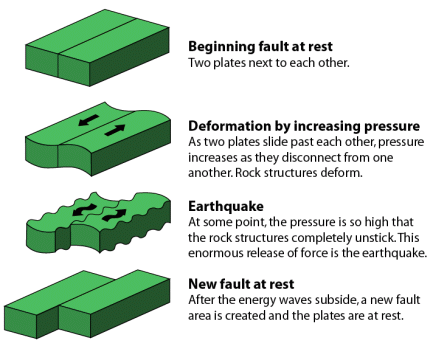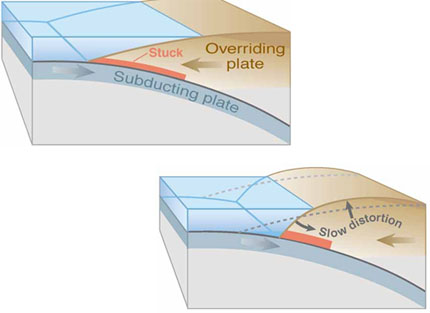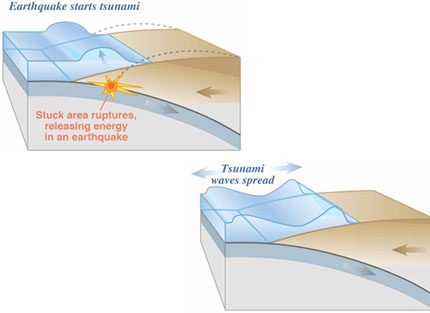Earthquakes
An Earthquake is movement along a fault caused by the rupture of Earth material.
Earthquakes occur in response to stress applied to rocks...rock breaks and there is a sudden release of energy which is felt as shaking.

Seismology: the study of earthquakes
Focus: the source of the earthquake: where the rock breaks, varies from surface to 700km.

Epicenter: the point on the Earth's surface above the focus.
Magnitude: how big the earthquake is...how much energy is released. This is measured by a seismograph or seismometer.
Seismometer: a heavy weight suspended from a frame which is connected to the ground. When the ground moves the frame moves but inertia keeps the weight from moving and a record of ground motion can be recorded.
Richter scale: scale of measurement for an earthquake. It is logarithmic... a
6.0 earthquake is 10 times stronger than a 5.0 earthquake and 100 times stronger than a 4.0 earthquake.
The Modified Mercalli Scale associates earthquake intensity to the amount of shaking felt.
Most earthquakes will occur along the edges of tectonic plates (there are some exceptions).
For an earthquake to occur rock material must break. Rock material under stress builds energy until the rock ruptures. Rupture releases stored energy. This energy moves out in all directions from the point of rupture: seismic waves.
Earth material breaks along a fault. The two sides of the fault are called the hanging wall and the footwall. The footwall is the side of the fault that would be the floor if there were a tunnel running into the fault. The hanging wall would be the ceiling.
There are three types of faults:
1) Normal Fault: the hanging wall has dropped down relative to the footwall.
2) Reverse or Thrust Fault: the hanging wall has moved up relative to the footwall.
3) Strike-Slip Fault: neither side of the fault moves up or down but the two sides move laterally past each other.
Different types of seismic waves are generated during an earthquake:
P wave: primary, push/pull or compressional. P waves move through liquid and solid material with the fastest speeds (4-7km/sec). P waves are the first to reach a seismograph after an earthquake.
S wave: secondary or shake. S waves move through SOLID material only. Slower than the P waves, S waves are second to reach a seismograph after an earthquake (2-5km/sec).
L waves: surface waves. L waves travel slowly along the surface of the Earth but can produce lots of ground movement.
P,S, and L waves are generated simultaneously when an earthquake occurs. They move out from the focus in all directions at varying speeds. The arrival time of each wave is recorded by a seismograph, by comparing the arrival time difference between the P and S waves the distance from the focus can be determined. Using arrival time data from three seismographs geologists are able to triangulate the location of the earthquake. A worldwide network of seismic stations continually monitor earthquake activity throughout the world.
Seismic waves have also been used to determine the interior composition of the Earth.
*Photo courtesy of USGS.
Effects of Earthquakes
1) Ground movement and shaking: displacement along a fault, even if it is small, can be enough to produce intense shaking. The type of earth material through which seismic waves travel will affect the amount of shaking felt on the surface. Unconsolidated material tends to amplify and increase shaking. The more solid the substrate the less shaking is felt at the surface. (Imagine a table with a pan of jello. The table surface shakes but the jello shakes more.)
Structures respond to shaking differently and engineers continually work to design buildings and roadways that will withstand the shaking produced by earthquakes.
Structures built along the fault will crack and become displaced by fault movement: roads, bridges, pipelines ect.
Ground cracks that open can be dramatic.
2) Fire: It has been estimated that 95% of all earthquake damage is from fire. Fires result from broken fuel and gas lines, ruptured fuel tanks and electrical shorts. Broken water lines impede firefighting.
3) Landslides: earthquake shaking initiates landslide, especially in unconsolidated material.
4) Liquefaction: Occurs in areas with high water tables or saturated soil and sediment. As the sediment particles are shaken the pore spaces between them fill with water and the sediment becomes like quicksand. Structures built on this material collapse or sink.
Subsidence: often the Earth's surface will sink or subside locally due to an earthquake.
5) Tsunami: Displacement of the seafloor caused by earthquakes set up waves in the ocean. These waves have long wavelengths (very deep) and travel very fast. Tsunami waves are barely discernible on the surface of the open ocean but as they approach a sloping shoreline they are pushed up to great heights. Tsunamis are most common in the Pacific Ocean and can travel across the ocean within hours. Tsunami waves occur in wave sets of 4-8 waves with up to an hour between individual waves.


6) Structural damage: earthquake shaking causes structures to crack and collapse causing large loss of life. In the United States earthquake research emphasizes preparedness and engineering...."earthquakes don't kill people, buildings do."
Earthquake Prediction
Geologists have studied many ways to predict earthquakes.
Dilatancy: a change in the volume of rock units due to squeezing as the rocks are stressed prior to rupturing. This change in volume causes a change in the electrical conductivity, fluid pressure and the conductivity of radio and seismic waves through the rocks.
Precursors: short and long term events that occur just prior to an earthquake:
-small tremors or microseisms
-surface tilting or warping
-anomalous animal behavior
-changes in electrical conductivity
-changes in the magnetic properties of the rocks
-change in velocity of seismic waves
-changing water levels in wells
-change in fluid pressure in rock units
Accelerometers are now used in some areas that will detect the arrival of the P wave prior to the S wave which allows time to turn off gas and stop elevators.
To date no reliable means of predicting an earthquake has been developed. Geologists and city planners use probabilities to predict long term chances of earthquake activity. By studying the geologic record geologists can determine the average length of time between earthquakes, their frequency and severity. This long range prediction gives planners and engineers time to renovate buildings and road systems making them safer during an earthquake. Building codes can be enforced in areas with high earthquake activity probability hopefully reducing property loss and casualties during an event.